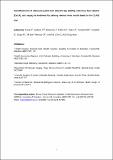Cost-effectiveness of ultrasound-guided foam sclerotherapy, endovenous laser ablation or surgery as treatment for primary varicose veins from the randomized CLASS trial
Abstract
Background: The treatment of patients with varicose veins constitutes a considerable workload and financial burden to the National Health Service. This study aimed to assess the cost-effectiveness of ultrasound-guided foam sclerotherapy (UGFS) and endovenous laser ablation (EVLA) compared with conventional surgery as treatment for primary varicose veins. Methods: Participant cost and utility data were collected alongside the UK CLASS multicentre randomized clinical trial, which compared EVLA, surgery and UGFS. Regression methods were used to estimate the effects of the alternative treatments on costs to the health service and quality-adjusted life-years (QALYs) at 6 months. A Markov model, incorporating available evidence on clinical recurrence rates, was developed to extrapolate the trial data over a 5-year time horizon. Results: Compared with surgery at 6 months, UGFS and EVLA reducedmean costs to the health service by 655 pound and 160 pound respectively. When additional overhead costs associated with theatre use were included, these cost savings increased to 902 pound and 392 pound respectively. UGFS produced 0.005 fewer QALYs, whereas EVLA produced 0.011 additional QALYs. Extrapolating to 5 years, EVLA was associated with increased costs and QALYs compared with UGFS (costing 3640 pound per QALY gained), and generated a cost saving (206-439) pound and QALY gain (0.078) compared with surgery. Applying a ceiling willingness-to-pay ratio of 20 pound 000 per QALY gained, EVLA had the highest probability (78.7 per cent) of being cost-effective. Conclusion: The results suggest, for patients considered eligible for all three treatment options, that EVLA has the highest probability of being cost-effective at accepted thresholds of willingness to pay per QALY.
Citation
Tassie , E , Scotland , G , Brittenden , J , Cotton , S C , Elders , A , Campbell , M K , Campbell , B , Gough , M , Burr , J M , Ramsay , C R & CLASS Study Team 2014 , ' Cost-effectiveness of ultrasound-guided foam sclerotherapy, endovenous laser ablation or surgery as treatment for primary varicose veins from the randomized CLASS trial ' , British Journal of Surgery , vol. 101 , no. 12 , pp. 1532-1540 . https://doi.org/10.1002/bjs.9595
Publication
British Journal of Surgery
Status
Peer reviewed
DOI
10.1002/bjs.9595ISSN
0007-1323Type
Journal article
Description
This work was carried out as part of a project funded by the National Institute for Health Research (NIHR) Health Technology Assessment (HTA) Programme (project number 06/45/02).Collections
Items in the St Andrews Research Repository are protected by copyright, with all rights reserved, unless otherwise indicated.

